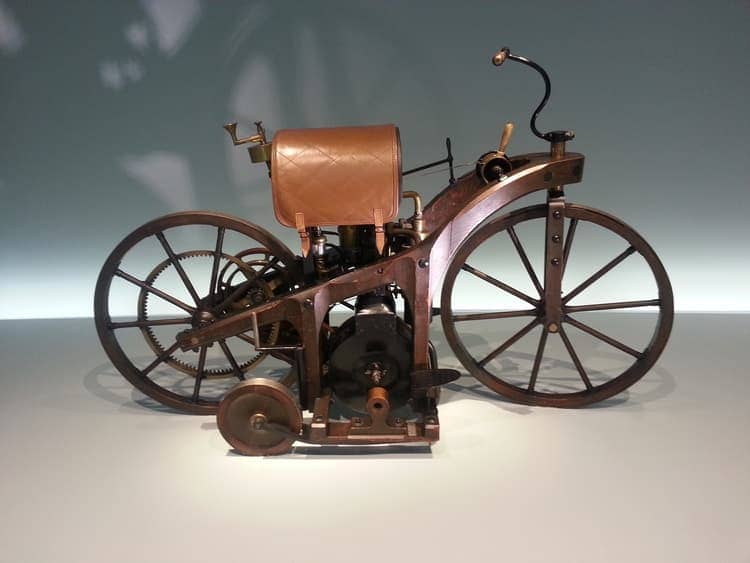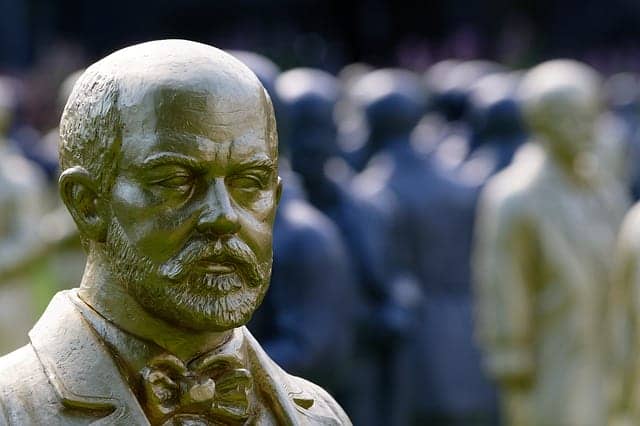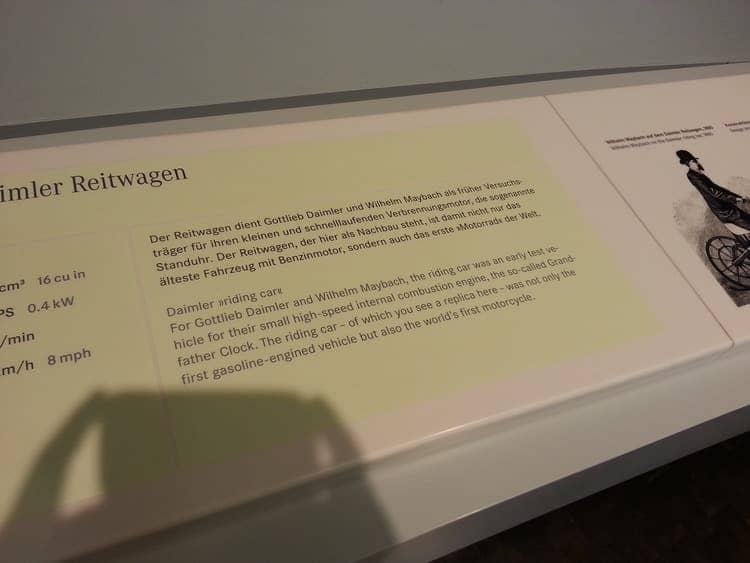
The history of our beloved motorcycles is intriguing to hear and learn about. Someone, somewhere had to invent them to make it possible for us to enjoy as they are today.
So, what is the oldest motorcycle in the world? Evidence and documentation suggests that the Reitwagen, created by Gottlieb Daimler and Wilhelm Maybach, is the oldest motorcycle in the world. Many inventors were working on making similar inventions at the same time, but historians tend to claim this the first motorcycle since it was gasoline powered.
There is a lot of history behind the Reitwagen including some debate about whether or not it truly was the original and oldest motorcycle. We’ll take a deeper look into it’s origin to help you understand a little bit better about this fantastic invention.
History Of The First Motorcycle
It was in 1885 that the forerunner of the motorcycle as we know it was invented. It is generally accepted that the first motorcycle was created by Gottlieb Daimler and Wilhelm Maybach. Daimler was an assistant to Nicholas Otto, who is credited with inventing the Otto cycle, or the 4-stroke cycle, of an internal combustion engine. Daimler had his own designs for an engine and partnered with Maybach to develop it. Daimler’s new engines were smaller and therefore more conducive to a one-person motorized vehicle.

Before the first motorcycle came about, there was much discovery about the engine and the bicycle. This set the stage for the two to be combined into what we would modernly recognize as a motorcycle.
Through the 19th century, the developing world was riding on the tail end of the industrial revolution. This was a period from 1760-1840 in which many technologies developed in agriculture, manufacturing, and the economy. This revolution began in Europe and carried over to the United States.
After the industrial revolution came an age of science. Individuals poured themselves into understanding scientific principles and had access to some technology and resources to test and prove theories. An example of this development is the advances in the combustion engine. Steam power was still popular for stationary engines and some locomotives, but people tried to scale the steam engine down with some success.
Around this same time, velocipedes became more and more popular. The term velocipede is defined as a human-powered vehicle with more than one wheel. This was used in place of the term bicycle before the bicycle’s commercial success. The penny-farthing was an early rendition of a bicycle recognized as having a very large front wheel. The concepts for pedals, cranks, and gearing weren’t solidified until 1885, which is also around when the first motorcycle was conceived.
There were a few attempts at a powered bicycle design during this time. During the late 1860s and into the 1880s, there were a couple of successful attempts at scaling down a steam engine to fit a velocipede. In 1897, there was an electric bike built in Great Britain, but it required very heavy batteries. None of these designs took off, even though the bikes themselves were operable.
Daimler and Maybach called their motorcycle Reitwagen, which translates to “riding car.” This invention set the stage for motorcycle technology to develop, which is why some refer to Daimler as “the father of the motorcycle.”
Specifications Of The Reitwagen

Compared to the technology of today, the Reitwagen appears rudimentary. Even for its contemporaries, it was a bit rough in design. But this first motorcycle had a few features that stuck around, primarily the gas engine, but also the twist grip handlebars to stop and go and a saddle.
This early motorcycle was designed to display the “Grandfather Clock Engine,” which was the focus of Daimler and Maybach’s work. They did not necessarily set out to create a motorcycle per se, but they did want to propel a vehicle using a petroleum-fuelled engine. This quest to invent the early automobile incidentally produced an early motorcycle. While Daimler patented his design, he did not pursue the development of it.
The engine on the Reitwagen measures 264cc but was only capable of about 0.5hp at 600rpm. This air-cooled four-stroke engine drove a single belt to the rear wheel. Not soon after, a two-speed transmission would be developed. The top speed for this bike was 11kph or about 6.8mph. It had no suspension with iron and wood wheels. Its total weight was about 200lbs.
Maybach developed a new type of carburetor that was integrated with the Reitwagen design. Previous carburetor designs drew air across a pool of fuel to capture the fuel vapors into the combustion chamber. This new carburetor utilized an atomizer nozzle similar to what is found in spray bottles. This invention went through patent legality battles and ultimately was not accredited to Maybach.
The original motorcycle doesn’t exist as it was destroyed in a fire in 1903, but a few replicas have been built based on Daimlers plans. These replicas vary in construction but are all based on the original designs. These replicas can be found in the Mercedes-Benz Museum in Stuttgart, Germany; the Deutsches Museum in Munich, Germany; the Honda Collection Hall in Japan; the AMA Motorcycle Hall of Fame in Ohio; and the Deeley Motorcycle Exhibition in Vancouver, Canada.
The Debate Around The First Motorcycle
While the Reitwagen is generally accepted as the original motorcycle, there is some debate surrounding this claim. There were several inventors at the time all working on a similar theory and the competition for patents was very heated. There are also a few discrepancies about Daimler’s design that create some disagreement based. However, there is evidence that supports the idea that this is the original motorcycle.
As was previously mentioned, there were several inventors designing bicycles fitted with steam engines. The Michaux-Perreaux steam velocipede was invented sometime between 1867 and 1871, which preceded Daimler’s Reitwagen by at least 14 years. The actual date of the invention is obscured as there are no verifiable records to reference.
Louis-Guillaume Perreaux experimented with fitting a steam engine to a Michaux 2-wheeled velocipede frame. Pierre Michaux was a blacksmith who has some credibility for creating the first bicycle. The Michaux-Perreaux produced 1-2hp and drove the rear with twin belts. The overall design was a compact bike that certainly is reminiscent of modern bikes.
Simultaneous to the Michaux-Perreaux was the Roper steam velocipede. Sylvester Roper was an American inventor based in Boston, Massachusetts, who likewise was experimenting with fitting a steam engine to a velocipede. Roper had two renditions, the first using a purpose-built frame and the second was built around a Pope Columbia “safety-bicycle,” which is a design more similar to modern bicycles as both wheels were the same size.
The debate around which was the first motorcycle is centered around steam engine versus petroleum engine. Some historians claim that since gasoline engines grew in popularity, the Reitwagen is the correct original. Steam engines quickly faded out in the years after these inventions, especially for vehicles.
However, the Reitwagen technically had 4 wheels. Since Daimler was trying to invent the automobile, he felt that the extra wheels were beneficial. But since motorcycles are defined as having two-wheels, some claim that this design does not qualify as being a true motorcycle.
By this definition, the claim tends to lean more towards the Roper design as it is based on the true geometry of a bicycle. The Reitwagen‘s steering lacked the rake and trail geometry that makes a true motorcycle functional. This is another point of contention in the debate about the first motorcycle.
What Came Afterward
Several other inventors were contemporary to Daimler and were aiming for a similar goal. For example, Lucius Copeland invented the Copeland steam bicycle. This design featured a bike with a large front wheel and a smaller rear wheel for steering. A functional model was created, except Copeland added another front wheel for stability. This steam engine produced 4hp at 2600rpm and was able to travel at 12mph. Copeland attempted to commercialize his invention, but business wasn’t lucrative enough.
There were also several inventions of a steam-powered tricycle that were built in the 1880s. Another design occurred much earlier in 1769 but Nicolas-Joseph Cugnot’s invention was not pursued. While motorized tricycles are popular today, modern trikes are more likely a stem from motorcycles adapted to a rear differential.
The first mass production of motorcycles came from Hildebrand & Wolfmuller based on an 1894 patent. Heinrich and Wilhelm Hildebrand were steam engine developers before collaborating on the motorcycle. The bike had a 2 cylinder, four-stroke engine developed by German inventor Alois Wolfmuller. The design had some flaws, like the lack of a clutch and instead the wheels being driven by the connecting rods. There were about 2000 of this bike sold and the company ultimately shut down.
Parallel to Hildebrand & Wolfmuller was the Excelsior Motor Company in England and the Orient-Aster motorcycle in the United States. It wouldn’t be until the end of the 19th century that major motorcycle companies would be established. For example, Triumph was established in 1898 with Indian and Harley Davidson coming in during 1901 and 1903, respectively. The first world war boosted motorcycle production which continues today.
